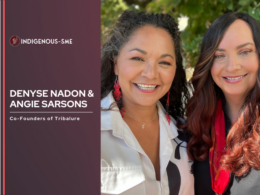Firstly, we are going to start off with a question, “What would it take to make sure that all Indigenous women in Canada have the opportunity to grow into an entrepreneur?” Although there isn’t any simple solution to a seemingly intricate issue, it is quite a known fact that entrepreneurship is a rising and promising path. To empower Indigenous women to enhance their lives, uplift their communities, and strengthen their families. All it can be achieved with relatively little action to bring a massive impact on enriching opportunities for Aboriginal women entrepreneurs.
To make entrepreneurship accessible to the Indigenous women of Canada, the country should:
- Develop gender-specific programs for Indigenous women;
- Create a special fund for Aboriginal women’s entrepreneurship;
- Facilitate access and promote awareness using the latest communication technologies.
The challenges that Indigenous women face while pursuing entrepreneurship are complex and diverse. Firstly, because they are women, and secondly they are Indigenous. It is vital to use an intersectional perspective when considering the challenges they face. This point of view emphasizes the fact that human experience is mediated by overlapping and multiple identities (race, gender, age) that collectively affect diverse people in many different ways. It helps us to understand how Aboriginal women face these challenges more than non-Indigenous women or Indigenous men, allowing us to develop solutions to meet their unique needs.
Benefits of Entrepreneurship
Entrepreneurship offers Aboriginal women many opportunities to enhance their lives by achieving stability and financial independence. We know that entrepreneurship is a difficult role, and especially for Indigenous women entrepreneurs, but can improve the socio-economic conditions of individuals and of communities as a whole. Today, Aboriginal women are starting businesses at twice the rate of Canadian women.

- Aboriginal women view entrepreneurship as a chance to refine their family’s quality of life and are also likely to pay off their loans compared to men.
- Their lives through entrepreneurship benefit the entire community.
Successful women entrepreneurs act as role models. Compared to the workplace, entrepreneurship offers many advantages to Indigenous women.
- Since entrepreneurs are bosses of their own, their work schedules are much more flexible.
- Entrepreneurs can set their own time and organize work according to their own schedule, simplifying work-life balance since family life is often a serious problem for women who bear most of the responsibility for raising their children.
- Having control over their own business means that they can choose the amount of responsibility they want to assume.
- Entrepreneurship also gives Indigenous women a sense of satisfaction and the purpose of creating something from scratch. This often allows them to work in a zone they are passionate about, making them much more successful than regular jobs.

Breaking Barriers
While Aboriginal women in the way of pursuing entrepreneurship face numerous challenges, one thing that sets them apart is their ability to overcome any challenges and their inspiring resilience. To effectively help Aboriginal women pursue entrepreneurship, understanding these barriers is highly important.
- Lack of Access to Capital for Equity
Since Aboriginal people live totally on reserve, they do not own any property. Thus, they cannot get loans from financial and traditional institutions for the need for collateral. Even with the capital, they still have to put share capital to qualify for a loan. High unemployment rates directly translate to difficulty in raising money for equity, especially for Indigenous women. It’s too difficult for them to save money for equity, ultimately making it invisible to the lenders. Lack of credit is also stated to be a major hindrance for Aboriginal women seeking loans.
- Inability to Work Full-Time
Many banks also require borrowers to work full-time, which is impossible for many women due to household responsibilities. Many women are attracted to entrepreneurship since it allows them to work part-time, helping them to balance several other aspects of their lives.
- Lack of Education
Lack of education, especially in the field of financial literacy, is also a major obstacle. Aboriginal people are less likely to complete secondary education than other Canadian groups. Since they are unable to sketch out a robust business plan or explore a financial institution, it turns out to be extremely cumbersome for them to get a loan.

- Lack of Confidence
Many Indigenous women are incredibly discouraged by being turned down by banks, causing some of them to almost give up their entrepreneurial spirit (although these women continued to take out loans from Aboriginal financial institutions). Lack of confidence is a big obstacle. This is partly due to a lack of mentors due to the continuing impact of boarding schools on other generations or a strong family support system. Children who are forcibly sent to boarding schools are now parents and often have difficulties raising children without continued nurturing. As a result, some Aboriginal women may feel they do not deserve good results, while others fear success.
- Lack of Access to Male-Dominated Fields
Two of the major engines of the economy – mining and construction are dominated by men, and women find it hard to penetrate. Thus, entrepreneurship is the only way to make them powerful and self-sufficient.
- Diversity of Circumstances
Indigenous women in Canada are a diverse group and the obstacles they face are very different. Métis women, specifically, face unique challenges. Many programs designed to help Indigenous women are not available to Métis women, and many companies are extending their responsibilities to consult only with Indigenous people, not Métis.
The situation is different with Indigenous women living on and off the reserve. People living on the reserve can own property that can be used as collateral, but they still face high unemployment rates disproportionately.
Similarly, Aboriginal people residing in isolated rural areas tend to have fewer job opportunities than those living in urban areas, making it difficult to find work to finance a loan. Residing in a remote location makes it difficult for them to access meetings and other programs from downtown. Any program to help Indigenous women should take these factors into account.
Recommendations
- To really back Aboriginal women engaging in entrepreneurship, nothing is more essential than launching programs specifically designed for them. For instance, caring for children through seminars and training makes it more accessible to women with family responsibilities.
- The content of the program should address topics related to Indigenous women. This means understanding how the objectives of entrepreneurship differ for women and men and changing the subject accordingly. For example, one program may target small part-time businesses. The other focuses on the types of businesses run by women in general and can provide advice on how to overcome the unique challenges women face when running these types of businesses. Finally, it is very important to showcase successful Aboriginal women entrepreneurs in these workshops or sessions. This not only demonstrates that participants can be successful but also offers entrepreneurs a rewarding opportunity to mentor.
- Finding new and stable sources of funding is important to enabling more Aboriginal women to start businesses. One such promising practice is to leverage co-financing by linking AFIs with a comprehensive track record of regional engagement and success with major financial institutions seeking to promote sustainable economic development via entrepreneurship.
Wrapping Up
The entrepreneurial spirit of Indigenous women can transform communities. Entrepreneurship enables Indigenous women to gain financial independence and security while increasing the status of others in society. However, enduring obstacles such as lack of fairness, credit, trust, and financial understanding are in many cases preventing and hindering Indigenous women from doing business. Placing indigenous women at the core of any program will help ensure that initiatives reflect the unique needs of these women. As funding is the most pressing issue, we believe the establishment of Canada’s first dedicated Indigenous Women’s Entrepreneurship Fund, run by Indigenous women, will be an important step in ensuring that starting a business should not be out of reach for Indigenous women.
Work Cited
Jakobsh, K., & Boskov, S. (2020). Breaking barriers: A decade of Indigenous women’s entrepreneurship in Canada. Women Entrepreneurship Knowledge Hub, Canadian Council for Aboriginal Business.
https://wekh.ca/wp-content/uploads/2020/12/Breaking_Barriers.pdf







